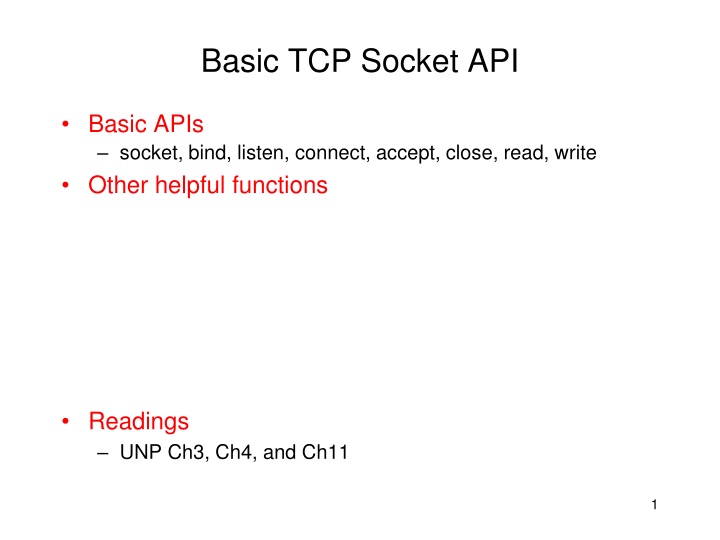
Basic TCP Socket API and Network Communication
Learn about the fundamental TCP socket API functions such as socket, bind, connect, accept, and more to establish network connections, along with explanations on creating sockets, binding them to local addresses, and using socket address structures. Explore the sequential server model and how to control IP addresses and port numbers effectively.
Download Presentation

Please find below an Image/Link to download the presentation.
The content on the website is provided AS IS for your information and personal use only. It may not be sold, licensed, or shared on other websites without obtaining consent from the author. If you encounter any issues during the download, it is possible that the publisher has removed the file from their server.
You are allowed to download the files provided on this website for personal or commercial use, subject to the condition that they are used lawfully. All files are the property of their respective owners.
The content on the website is provided AS IS for your information and personal use only. It may not be sold, licensed, or shared on other websites without obtaining consent from the author.
E N D
Presentation Transcript
Basic TCP Socket API Basic APIs socket, bind, listen, connect, accept, close, read, write Other helpful functions Readings UNP Ch3, Ch4, and Ch11 1
Connection-Oriented Application 1. Server gets ready to service clients Creates a socket Binds a local address to the socket Server s address should be made known to clients Client contacts the server Creates a socket Connects to the server Client has to supply the address of the server Server accepts connection requests from clients Further communication is specific to application 2. 3. 4. 2
Creating a Socket #include <sys/socket.h> int socket(int family, int type, int protocol); Family: AF_INET, AF_INET6, AF_LOCAL, AF_ROUTE, AF_KEY. Type: SOCK_STREAM, SOCK_DGRAM, SOCK_RAW TCP: AF_INET, SOCK_STREAM UDP: AF_INET, SOCK_DGRAM IPv4: AF_INET, SOCK_RAW Protocol: usually 0 except for raw sockets Return descriptor (like file descriptor), -1 on error. AF_XXX and PF_XXX 4
Binding Socket with a Local Address int bind(int sd, const struct sockaddr *addr, socklen_t len) sd: socket descriptor returned by socket() addr: pointer to sockaddr structure containing local address to be bound to socket len: length of address structure Returns 0 if success, -1 otherwise Optional to client Servers normally need to bind system assigns a dynamic port number (when connect or listen is called) 5
Socket Address Structure struct in_addr { in_addr_t s_addr; } struct sockaddr_in { uint8_t sa_family_t in_port_t struct in_addr char } sin_len; sin_family; sin_port; sin_addr; sin_zero[8]; struct sockaddr { uint8_t sa_len; sa_family_t sa_family; char sa_data[14]; } 6
bind() Controlling IP addresses and port numbers when filling the socket address Address INADDR_ANY 0 INADDR_ANY !=0 system selects addr, user selects port Local IP address 0 user selects addr, system selects port Local IP address !=0 user selects both addr and port port result system selects addr and port 7
Client: Connecting to a Server #include <sys/socket.h> int connect(int sockfd, const struct sockaddr *servaddr, socklen_t addrlen); Servaddr: socket address structure (ip address and port) connect() actively starts the TCP connection establishment phase. Possible errors: No response: retry a number of times before it quits. Get response RST (not SYN/ACK), ECONNREFUSED, nobody is listening in that port Get ICMP response, keep trying, EHOSTUNREACH or ENETUNREACH. 8
listen() Convert an active socket into a passive socket #include <sys/socket.h> int listen(int sockfd, int backlog) Backlog: number of connections that the kernel should queue for the socket. Two kind of queues (incomplete and complete) Backlog not well defined. E.g: backlog= 5: AIX 4.2(8), Linux2.0.27(5), SunOS4.1.4(8), Solaris2.5.1(6). 9
Server: Accepting Connection Request #include <sys/socket.h> int accept (int sockfd, struct sockaddr *cliaddr, socklen_t *addrlen); Return client s address in cliaddr Blocking by default See example1.c and example2.c After accept, the TCP connection between client and server is established. You can then use the write/read to communicate data. Read and write have the same semantics as the read and write for file operation. 10
Some Useful Functions Converting the byte orders #include <netinet/in.h> uint16_t htons(uint16_t host16bitvalue); uint32_t htonl(uint32_t host32bitvalue); uint16_t ntohs(uint16_t net16bitvalue); uint32_t ntohl(uint32_t net32bitvalue); Some byte manipulation functions: #include <string.h> void *memset(void *dst, int c, size_t len); void *memcpy(void *dst, void *src, size_t nbytes); void *memcmp(const void *ptr1, const void *ptr2, size_t nbytes); 11
Some Useful Functions Address conversion functions inet_aton/inet_addr/inet_ntoa inet_pton and inet_ntop // these are newer ones Information about socket getsockname and getpeername getsockopt and setsockopt Name and address conversions gethostbyname, gethostbyaddr getservbyname, getservbyport getaddrinfo, gai_strerror, freeaddrinfo // newer ones 12
Echo Client and Server See echo_client.cpp and echo_server.cpp Note that, the client program may be blocked forever, even if the server crashes, if the user does not type anything after the connection has been established. 13
